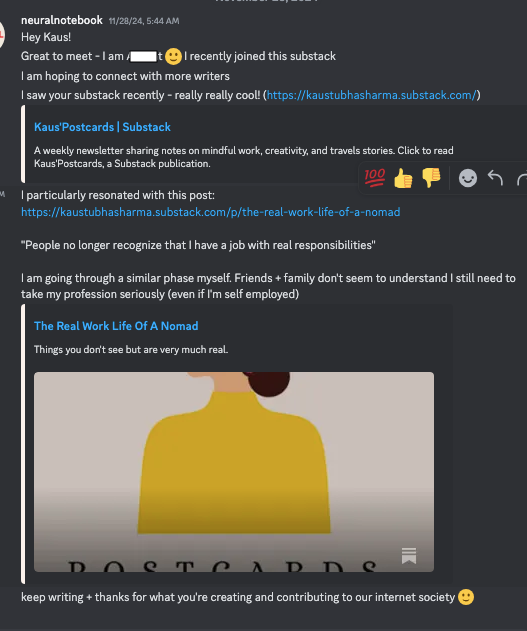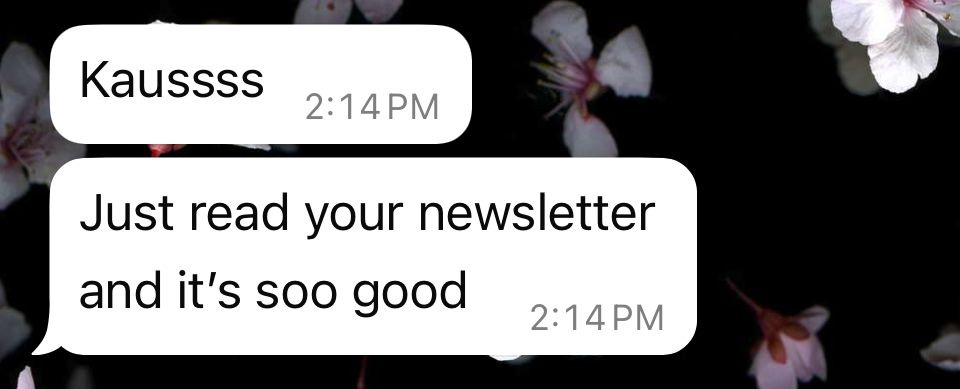Building My Work Boundaries - Intentionally (Part 3)
Sometimes adding more No-s over Yes is more satisfying.
Welcome to the Slow Work & Business Series!
This is a space to explore how work can feel joyful, mindful, and less overwhelming. As someone navigating life after the rush of traditional work, I’m documenting my journey—projects, lessons, and all the highs and lows. If you’re redefining work on your own terms, let’s figure it out together with heart and ease.
Before I get to the issue, I would like to share something awesome that happened over the week.
I get to welcome 3 new people on the reader list. Yay! →
Welcome, Denae, Naina, and Kuriakin! I am happy to have you on Kaus’ Postcards reader list.
And, and, I got really nice compliments! This made my day! (I saw it really late thou)
Only if they were easy to keep: Boundaries!
I have been in a constant struggle between growth and stagnancy, between structure and flow. Somehow, I can never find a balance. I want to create more spaces for things other than work and that is why I need to reevaluate my work boundaries so they could protect all areas of my life. Work has a way of sweeping into other parts of my life because I have been too set in my corporate ways.
I keep bashing this part of me (I am also trying to be kind), but it has trained me all my life—in school and after.
But now, I want to bring everything out in me.
I want to get bored, read, garden, draw, learn languages, practice debate—not for any aim or purpose, but just because it feels fulfilling. Life feels too restrictive when I try to do things for an objective—it could be monetary, getting better, but the point is, I feel that when there’s no attachment to an objective, the ultimate result naturally leads to a developed skill, knowledge, or, luckily enough, monetary benefits.
When the focus is on the play or the process without an attachment to the outcome, it feels lighter and easier. I have been trying to move towards a more process-oriented approach these days.
I digressed.
Back to boundaries: My boundaries have expanded and shrunk over the years.
In my corporate years, I didn’t know what a boundary was.
I worked with whoever, got paid whatever, and worked anytime.
The only thing was that there was a defined transition between work and personal life, but even that extended into my personal space sometimes.
Over the years, through all the ups and downs, I have learned to cultivate work boundaries based on my values and my intentions—most importantly, on the “feels” over the “musts”. I still have a long way in learning how to navigate these as a solopreneur, but I think every time I learn something about my work approach and the feelings it brings, I do something better. It is like meditation, really. It needs a lot of observing how I behave when I work and how I float through it.
Here’s a look into how I have created my boundaries so far and what I still struggle with. I hope you walk away feeling calm and hopeful about your new journey or the journey to come—as a solopreneur, freelancer, or anything non-traditional.
People
Choosing my colleagues! All my life, I was taught to take whoever walks in first. Clients were treated godlike. In ad agencies, clients could behave poorly, scrap an entire campaign, and even call you during vacations, yet you were expected to be up and upbeat about it (at least that was my story, I hope if you work in an ad agency you have a better story).
Traditional approaches often focus on taking as many clients as possible. They disregard compatibility and mutual understanding. It’s just about the initial money.
Now, this isn’t entirely bad if reframed into a mutually-respectful approach. But as it stands, it’s unhealthy. It doesn’t account for mental well-being, personal life, or balance.
Let’s address the idea of working with as many clients as possible in the beginning.
Quantity has its value—it helps you master your skills and understand what kind of quality you need in your work life.
But even then, we need to define our values.
After quitting, I was firm about the kind of clients I wouldn’t work with, even if it meant taking longer to find the right ones. I won’t sacrifice my mental well-being.
These were my red flags for an unhealthy client:
They tend to negotiate your price point. A healthy client will always work around your price point, but they will not bargain your services. This shows that they value and respect the years of experience you bring to their business.
They don’t show up on time for meetings or inform about canceling meetings in advance. They are also not apologetic for this behavior and tend to give excuses rather than changing their behavior.
They want more than what was mutually agreed upon earlier.
They sweep into your life beyond work hours, messaging whenever they feel like it.
I constantly feel stressed because they take up so much of my mental space, and my body literally wants to avoid these calls.
They don’t do their part as promised.
Late payments.
Do you have red flags for clients you look out for?
A bad client will lead to a network of poorly-behaved clients and, most importantly, poor mental health. Even if you have other clients, that one client will add so much stress that you lose all motivation to work.
On the other hand, a quality client will lead to quality connections. You would always look forward to meeting them because these meetings would feel calming, joyous, and inspiring. You would naturally want to work for them.
Work relationships are equally important as they take up so much of our time and mental capacity, so they might as well be good enough—or more so, enjoyable enough—to take up space in my life.
And what happened after I made this boundary contract with myself? Since these boundaries, I have never worked with an unhealthy client. All my work people are wonderful, inspiring, and super healthy individuals who also teach me and help me grow.
No matter what other people say, do not budge from this. You deserve to work with people who bring out the best in you.
If you want to know more about how I developed these boundaries, let me know. :)
Money
I still struggle with this, but I am getting better thou. One of the things I learned from a business coach is to avoid looking at whether a person can pay you—more precisely, keep out of their wallet because it’s not your business. Quote as per your values and experience, and double the amount. Then see how it pans out—most likely, people will pay. This advice feels weird because I am still not comfortable with increasing my prices, and I write this article at a time when it’s due for me to inform my clients about my service charge increase.
I also thought about it this way: in service-based businesses, we price our hours of work but often overlook the value and experiences that come along with it. We might complete something in 30 minutes, but that doesn’t mean we should charge less. Being able to accomplish tasks quickly comes with years of practice and rich experience.
I’ve also realized that if I focus on the actual value of my contribution, the price I quote might not feel so scary. For example, if I write for a website and their client base doubles after an update, yet I quoted only 5% of that result, I am underpricing myself. Instead of sticking to standard price points, I’m teaching myself to focus on the value I provide and the results my efforts bring. This shift also leaves me feeling happier and more satisfied with my work.
Here are my current work-money boundaries (still a work in progress):
Focus on the value, not the hours.
Increase the price, even if it feels scary—you’re likely quoting much lower than you deserve. (Wish me luck; I’m about to do this soon!)
Time
I didn’t want to work eight hours a day again. What’s the point of leaving a traditional job only to work as a traditional worker again? So, I decided to start by taking Mondays off.
Eventually, I transitioned to working four hours a day, which is what I try to do now.
My ultimate goal is to reduce my work hours further and dedicate more time to hobby projects that can be monetized while bringing me joy.
Here’s my time approach:
Four hours of work per day—no more, no less. This helps me focus on what’s important.
Be strict about meetings: be on time and leave on time. If I want to chat later, I can, but work calls need time limits.
Work Approach
I’m more of a writing person. Whenever I feel overwhelmed, writing things out gives me immediate relief. But first, I have to bring awareness to the overwhelm.
I tend to get stuck in overzealous creativity, which often leads to shame and, ironically, more overwhelm.
To establish work boundaries, I need to first understand how I flow and function. I need to pause, reflect, learn, and understand.
Think of it like watching a toddler learn to walk or seeing a bird fly in the sky—you observe, you become familiar, and then you discover.
What I’ve discovered about myself is that I fail under rigidity, structures and deadlines. Deadlines terrify me. I function much better with flow, so I need loose ends of time.
But structure is essential because it keeps me flowing. Imagine structure as the banks of a river and flow as the water. Structure guides me to where I want to go.
So I have started to have more floating time (where I am free to do whatever I like) and only a few hours of structure that helps me focus.
Here’s how I navigate my work approach:
Respect your natural work style—it’s okay to have more flow and less structure.
For projects involving others, set two deadlines: This helps to remain calm under pressure.
To help me complete a project, I will only keep one big project that I focus on until it is finished.
Whenever I am overwhelmed (which is a lot of times but it is getting better), dump it all on a page. Write your thoughts. Everything. Put it all out of your mind.
To maximize work hours, instead of diving right in, I will pause and ask myself three questions before starting it: What’s the point here? How can I get this done faster? How can I make it fun?
I am still struggling with my four-hour workday. It’s a slow approach to finishing projects, but it’s better for other areas of my life. I’m not strict with time blocks, and I’m still figuring out what works for me.
I’ve added more fun hours to my calendar—more time outdoors, reading, and learning things for pleasure.
I am also navigating how to finish projects in a way that aligns with my personality and values.
I’ve removed: rigid deadlines, excessive structure, and the traditional “workday” mindset.
Do you have work boundaries? How have you navigated them?
Read The Whole Series Below
Part 1: Why I Left Traditional Work
Part 2: Building A Life After Traditional Work
Part 3: Building My Work Boundaries
Part 4: How To Prepare Life After Traditional Work
Part 5: Why Slow Work makes More Sense
Part 6: Lessons From My First Meditation Course
Part 7: Years of Navigating Work Rush & Anxiety
Part 8: How I Am Learning To Trust The Process
Part 9: The Quiet Math of Worth: Self-Employment Reflections
Part 10: The Last One: Lessons from a Life-Designed Business
Let’s connect!
If you’re walking the self-employed path, or even just dreaming about it, I hope this postcard reminds you that you’re not alone. You’re not behind. You’re just building something honest, and that takes time.
And if you’re starting out or maybe experimenting with freelancing, teaching, or offering something personal to the world, here’s something to help you get going gently: Things I Created For Freelancers. I have created multiple things whatever has helped me over the years. Check it out, maybe you will find something that you will like.
It’s my dream to work with a therapist who is also has a Yoga business. If you know anyone out there looking for help with marketing, please do let them know that I am here, dancing and jumping up and down my chair waiting to meet them.
Here’s my beloved, I invite you to drop by→ Kaustubha
I hope you’re enjoying Kaus’ Postcards. I started this publication to cultivate a writing practice and connect with people through my writing. I’ve decided that after my 100th post, I will open the publication for monetary support. Currently at 69/100.







Thank you for this Kaus! As always, very inspiring to read. What I would love to know is how you started being a solopreneur. Once you quit, what did you do? How did you find your clients, market your services? I am in a similar boat, working at an ad agency and considering going freelance. But the thought of how to make it work seems daunting.